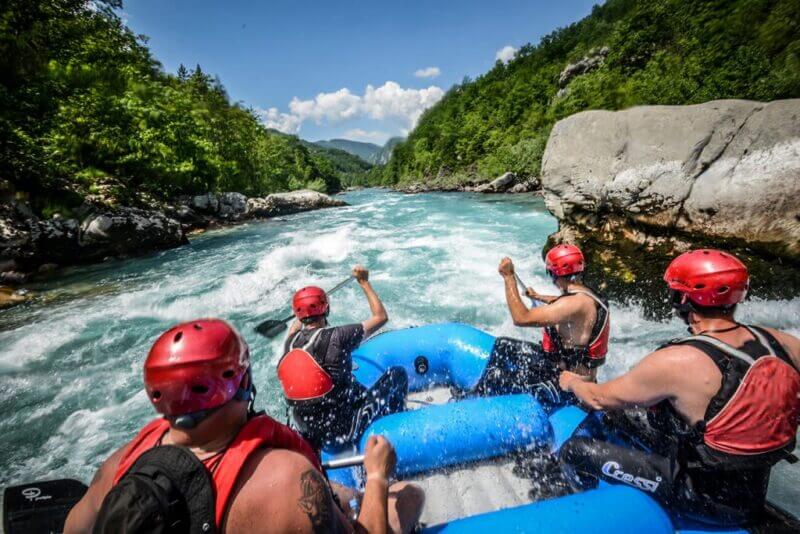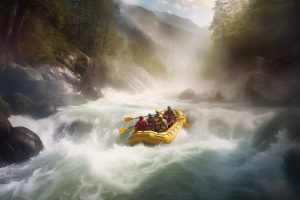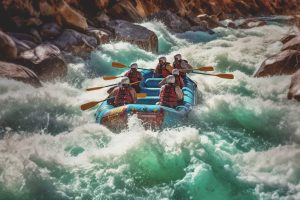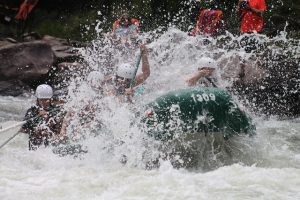Whitewater rafting and kayaking are both very popular recreational outdoor activities that use an inflatable kayak to navigate an open river or other bodies of flowing water. This can be done either on a flat or rough river bottom or on some other steep bank.

While kayaking and rafting go hand in hand, both of these activities are extremely dangerous and require proper equipment. This is usually a combination of whitewater skills and river knowledge that a lot of people who engage in kayaking and whitewater rafting don’t have.
Whitewater rafting is an ideal activity for both experienced and novice boaters alike. Often referred to as river rafting, this style of whitewater sailing involves using a paddle and oars to propel oneself over rapids and waterfalls. This also provides a great deal of excitement and thrill for many boaters. The thrill of being propelled down a rapids or deep valley can be extremely thrilling. As such, it is not always a good idea to embark on a whitewater river rafting adventure without a good amount of experience and a good plan.
Whitewater rafting is typically undertaken during hot summer months and typically requires the assistance of guides and other equipment to ensure a safe experience. Although some river rafting companies do provide guides for free, the best way to go would be to hire a guide if you have the budget.
In general, most whitewater rafting trips include some form of guided instruction. Usually the information is provided by local guides that are familiar with the area you are visiting. These guides are trained and experienced in river rafting, and can help to provide you with a safe and secure raft trip. If you want more information, you can speak with your guide about safety equipment and how to stay safe along the river.
It is always a good idea to bring a first aid kit along if you are participating in whitewater river rafting. This kit will help you should you become injured while traveling and can often save the day. The kits will usually include a hand held first aid kit, an assortment of bandages, and possibly a first aid kit in case of an emergency.
Whitewater Rafting Trip
When kayaking a river, there are many things that can go wrong and end up in an accident; whitewater rafting is no different. There is usually no way to tell when you will come up against a river obstacle, and it is when it happens that the kayaker has to be very alert. Being aware of possible dangers is something that a lot of kayakers do not do enough.
There are a number of different things that can go wrong. Most kayakers don’t realize that there are rocks or other obstacles that can cause the kayaker to veer off course. Sometimes the kayak doesn’t even see the obstacle until the moment before it hits them.
Whitewater rafting is one of the most dangerous recreational sports but is also one of the most rewarding as well. It requires plenty of skills but also a lot of physical fitness.
The kayakers use ropes to pull themselves into position and a paddle to propel themselves forward. They also wear flotation devices and helmets so they can stay safe underwater.
River Rafting Trip
One important aspect of kayaking is being able to stay afloat; if the kayaker begins to sink, they usually have a tough time getting back to land. Even if the kayak has all its supplies on board, they still need to be able to stay afloat. This is why it is important to have the appropriate flotation gear. A wide-brimmed hat is usually recommended for a white water kayaker; one that is wider than the kayaker’s shoulders will work best since it will keep more water out.
River rafting is a great way to relax and take in the scenery. But it is also a good idea to have the right equipment for your trip. With this in mind, the guides you hire can provide you with the tools you need to make the trip as safe as possible. If you have never taken part in river rafting before, you may want to consult with a guide to give you some basic information and guidelines.
Whitewater rafting is a good option for anyone who has never participated in the activity before. And you should definitely consider hiring a river rafting guide to help you along the way. It can be a very enjoyable and rewarding experience!
Kayaking and whitewater rafting also involve a good amount of teamwork since the kayakers must work together to make the safest possible landing. There are a number of safety gear items that can help ensure that a kayaker doesn’t become buried and stuck in water rapids; it is always best to wear them along with the rest of the group. This includes a chest harness that is designed to prevent one from sinking, a flotation device that can float the person above the surface, and a raft. While on the raft, it is also important to wear a chest protector and knee or ankle support.
The kayakers need to know how to swim and maneuver in deep water, especially if the river is wide and open. This is something that most people who kayak often overlook, but it is very important to be able to maneuver properly in a river. If one of the kayakers is knocked unconscious or drowns in a river, it is a pretty good bet that he or she will never be recovered unless rescue is immediately called.
Whitewater rafting can be very exciting, but there is always the chance of tragedy or accident. Kayakers and whitewater rafters must be careful and be on top of their game at all times so that they can avoid these kinds of accidents.
River Rapids
There are also hazards that can occur when the rafts go up rapids, and this is something that kayakers and rafters have to learn to prepare for as well. Rafting rapids can be very dangerous and can be incredibly scary for kayakers and rafters. If an accident does happen to someone in a river or on a raft, the first thing that should be done is to get into the nearest house and call for help.
While whitewater rafting can be very dangerous, there are a number of things that can be done to help ensure that an accident doesn’t occur. It is a good idea for kayakers and rafters to go through a course where they know exactly what to expect and know how to deal with situations if one does happen.

For instance, some whitewater kayakers and rafters enjoy going through a rapids course where they can practice what they would do on a river because they can learn how to maneuver in the water without worrying about any unexpected obstacles or water issues.
However, most kayakers and rafters choose to go through a course where they can not only ride through rapids safely but also take a few lessons so that they are able to deal with problems that might occur in the middle of the water, such as rocks, falling trees, and other forms of trouble that can occur when going on a rafting trip.
Conclusion
Well, there you have it, folks, the heart-pounding, adrenaline-rushing, utterly exhilarating world of white water rapids! It’s a dance with nature as you navigate the frothy rapids of a river in a buoyant, inflatable raft, paddling hard to keep your course.
Whether it’s the grandeur of the Colorado River carving its way through the Grand Canyon, or the steep, challenging flow rate of the Gauley River, whitewater rafting is an adventure sport that offers something for everyone. Novice or expert, it’s about embracing the white water, the river forms, the boulders, and the obstructions.
You’re in safe hands with experienced river guides and stringent guide training, ensuring every rafting trip is not just an exploratory thrill ride but a safe and fun experience too.
From self-bailing paddle rafts filled with air for rigidity to the neoprene wetsuit keeping you warm in the aerated waters, every detail is meticulously planned by rafting companies.
If you’re a thrill-seeker, the rafting community welcomes you with open arms. The International Rafting Federation even offers head-to-head slalom and downriver events for the competitive paddlers among us.
White water rafting isn’t just a recreational outdoor activity, it’s an invitation to bond with nature in its rawest form, a chance to create unforgettable memories, and heck, it’s a heck of a lot of fun! So come on, grab an oar and raft with us… are you ready to ride the river?
FAQs
What exactly is whitewater rafting?
Well, folks, whitewater rafting is a high adventure sport where you navigate a river in an inflatable raft. It’s not just any river, though, we’re talking about white-water rapids, those frothy, fast-moving parts of the river where the current gets a bit wild. It’s a heart-pounding, exhilarating journey that’s part river reading, part paddle power!
How does one prepare for a whitewater rafting trip?
Preparation is key, my friend! First and foremost, a proper guide is essential. They’ve got guide training that helps ensure your rafting adventure is safe and fun. You’ll also need a personal floatation device, and depending on the water temperature, you might need a wetsuit. And remember, always pack a first aid kit. It’s better to have it and not need it than need it and not have it!
What kind of equipment is used in whitewater rafting?
Good question! At the heart of the sport is the raft, typically an inflatable boat filled with air for rigidity. You’ll also need paddles or oars to navigate the rapids, and let’s not forget the personal floatation devices for safety. Some rafts might even have a metal frame at the back for those steeper, rougher sections of the river.
What are the different degrees of rough water?
Hold on to your hats, and it’s about to get bumpy! Rapids are graded on a scale from I to VI. Class II and III are considered intermediate and are perfect for beginners, while grades IV and higher are for the more experienced river runners. Grade VI, now that’s the Everest of rapids, rarely attempted and very dangerous.
Can anyone try whitewater rafting?
Absolutely! From novices to seasoned pros, whitewater rafting is one outdoor recreational activity that welcomes everyone. Depending on the grade of the rapids, the river features, and the current, there’s a rafting experience for all skill levels. So come on, grab a paddle and raft with us. It’s an adventure you won’t forget!

